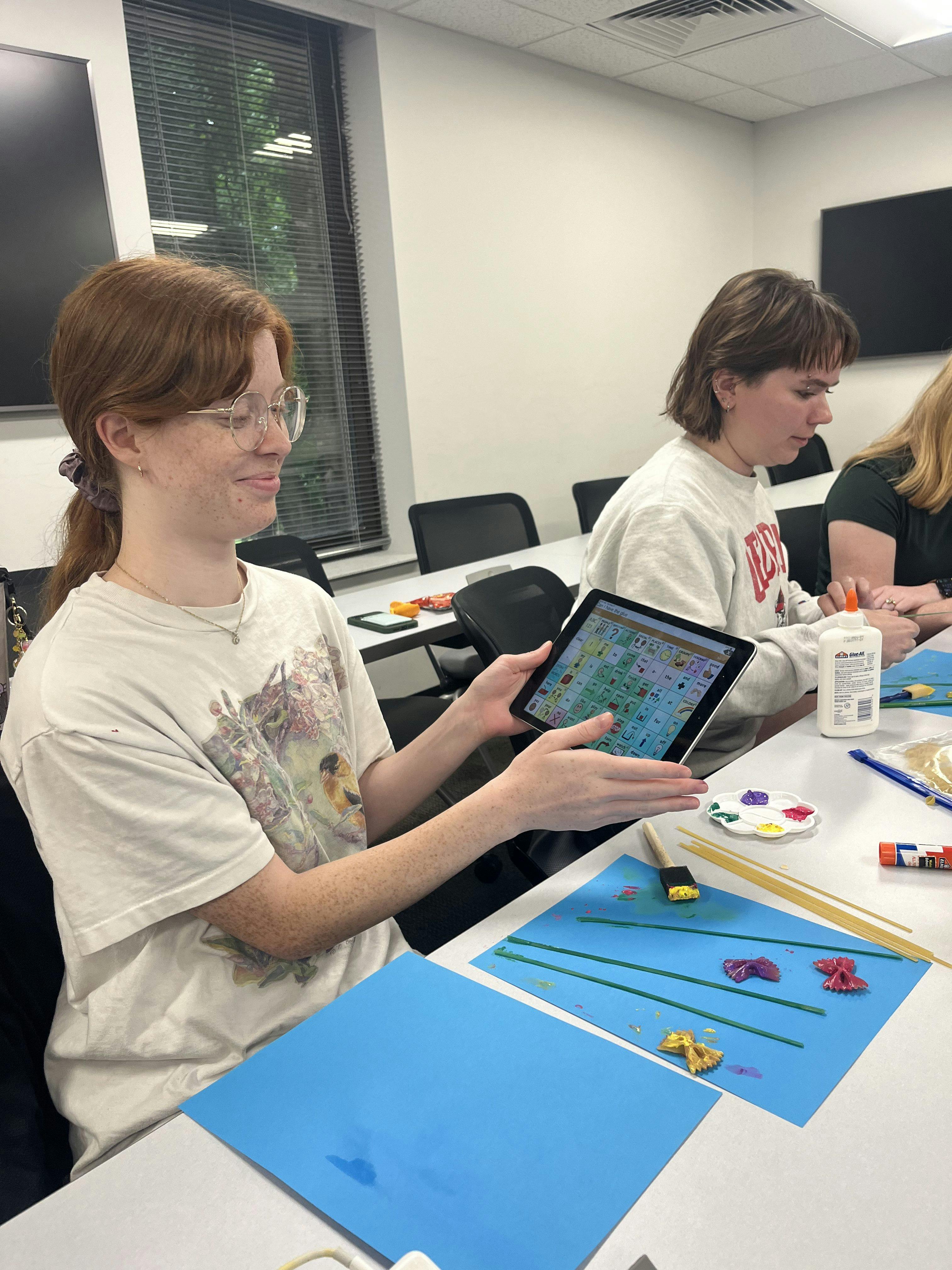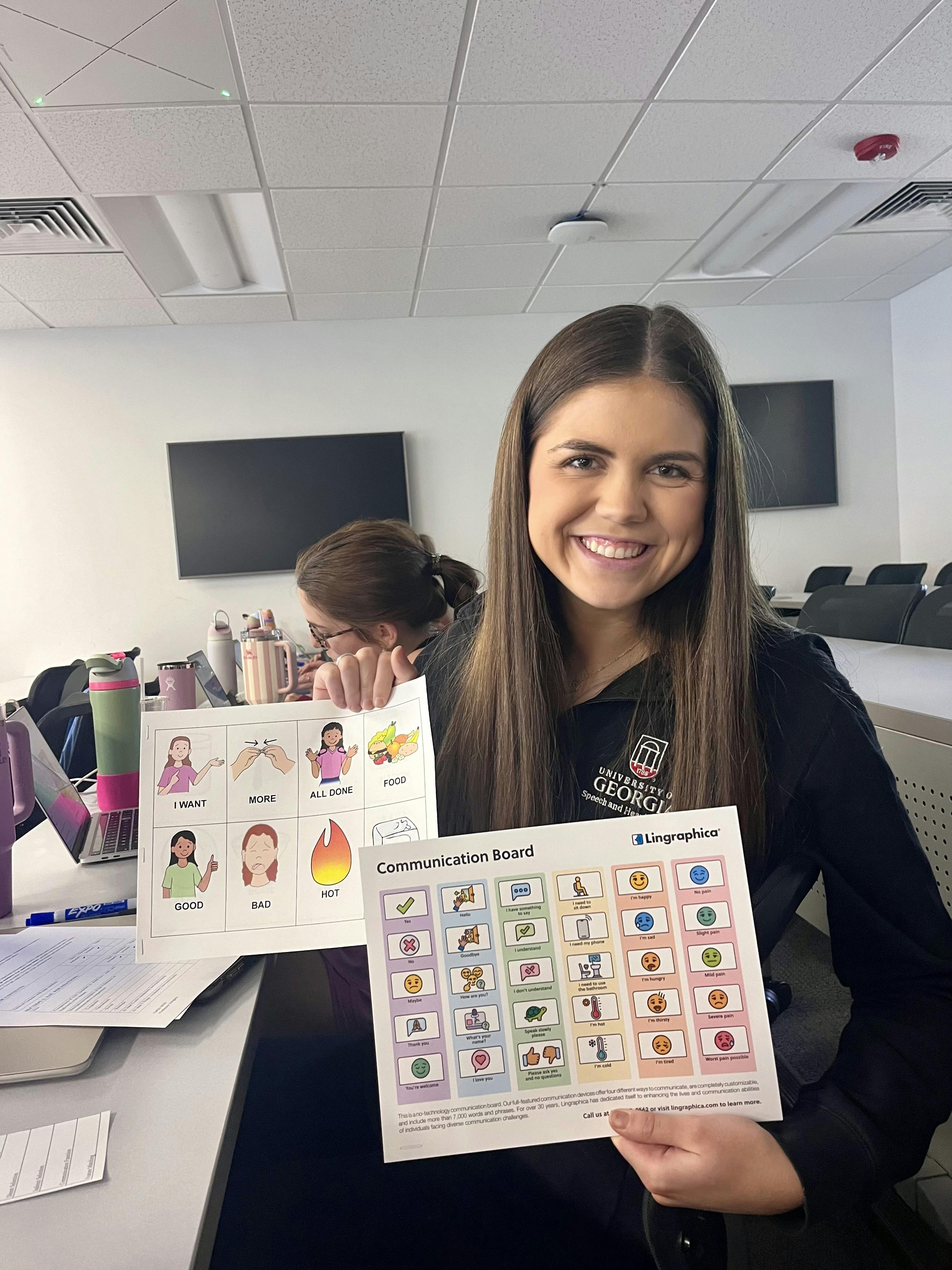A six-day course taught in the Mary Frances Early College of Education provides future speech-language pathologists with hands-on experiences with assistive technology.
The intensive course takes place every summer for graduate students in the communication sciences and disorders program who just completed their first year, and it’s one of the only courses of its kind in augmentative and alternative communication (AAC).
“[AAC] is anything outside of using your verbal speech to get your point across, whether that’s adding to verbal speech that you have, or for some people, that is their whole communication system,” said Ainsley Vergara, a clinical assistant professor in the Department of Communication Sciences and Special Education who teaches the course. “So, it can be things like gestures all the way through using iPads that have built in language systems to communicate.”
 AAC technology includes computer- or tablet-based apps that display a grid of words, phrases, and symbol-based categories. Users navigate through the visual layouts to select individual icons or words which are then combined into phrases or sentences and spoken aloud by the device, allowing individuals with complex communication to express themselves effectively.
AAC technology includes computer- or tablet-based apps that display a grid of words, phrases, and symbol-based categories. Users navigate through the visual layouts to select individual icons or words which are then combined into phrases or sentences and spoken aloud by the device, allowing individuals with complex communication to express themselves effectively.
Speech-language pathologists (SLPs) often work with clients who use AAC devices, spanning across age groups from children to older adults, and across work settings such as hospitals, private practices, or schools. However, students may enter the profession with limited or no experience working with AAC clients.
“Most SLP graduate students, the experience they get is just what they happen to get on their client caseload. Some people will graduate having never worked with AAC, and then they get into settings and it’s prevalent in every setting,” Vergara said. “Some SLPs will have a ton of AAC clients, and some will have one or two, but every SLP will have an AAC client. So, we’re preparing our students to go into whatever setting and to use the technology.”
After lectures on the foundations of AAC on the first day of class, students spent the week working hands-on with the different devices to familiarize themselves with the different AAC technologies and how to use them. Several guest speakers visited the class throughout the week, including an AAC user and his mother and several major producers of assistive devices.
 Another hands-on aspect of the course took place at lunchtime, where students ordered lunch at Tate Student Center using an assistive device. Sophie Stepp (M.Ed. ’26), a graduate student in communication sciences and disorders who took the course this summer, said the experience was eye-opening and provided a glimpse into the challenges people face when using the devices to communicate.
Another hands-on aspect of the course took place at lunchtime, where students ordered lunch at Tate Student Center using an assistive device. Sophie Stepp (M.Ed. ’26), a graduate student in communication sciences and disorders who took the course this summer, said the experience was eye-opening and provided a glimpse into the challenges people face when using the devices to communicate.
“They got to see what it feels like to either be the person using a device and ordering or being the speech therapist with that person providing the support that they needed in the community, so they were able to feel all the emotions that come with being a device user, and that was a really impactful experience,” Vergara said.
For the course, Vergara uses a process called “ungrading,” where students do not receive numerical grades and are encouraged to focus more on exploration and problem-solving rather than “perfect” responses. Instead, students complete reflections to justify their grades based on criteria they help decide, including attendance, critical thinking, and professionalism, along with daily learning logs that reflect on both the skills they developed and their feelings throughout the process.
“This is so hard to learn as a therapist, but then it’s way harder for a client or their families to learn how to navigate these [technologies], so I wanted them to find emotional connections to the things that we were doing in class,” Vergara said.
For Stepp, who had already encountered AAC through clinical work at the Speech and Hearing Clinic, the course strengthened her understanding of the subject matter.
“My favorite part of the AAC course was learning how to see each client as a whole person, not just someone with a communication disorder, but someone with unique strengths, needs, and life experiences,” Stepp said. “I came to understand how important it is to assess across multiple areas, like thinking skills, physical abilities, and social needs, in order to choose the right communication tools.”
